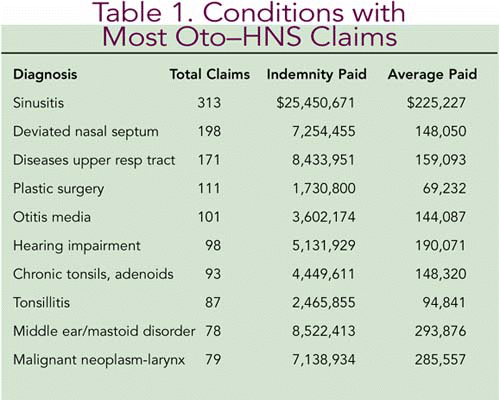SAN DIEGO-Although expenses related to medical malpractice are often seen as a cost of doing business, the experience of litigation is a personal, as well as a professional assault. A malpractice suit attacks a physician’s integrity and confidence.
Explore This Issue
June 2007Douglas E. Dawson, MD, MS, from Unity Health Care in Muscatine, IA, and Eric Kraus, MD, MS, with The Ear Center of Greensboro, NC, have experienced the unpleasantness of malpractice litigation. As did many other physicians and surgeons, they found the language, concepts, and rules of the legal system to be foreign territory. The two otolaryngologists wondered if a better understanding of malpractice statistics, vulnerable areas, and aids to coping would be helpful for other specialists in today’s litigious society.
In an American Rhinologic Society presentation April 26 at the Combined Otolaryngology Spring Meetings, Dr. Dawson represented the two in providing a description of their recently completed research project, titled Medical Malpractice and Rhinology.
Analysis of Claims Data
The physicians analyzed 20 years of data from the Physicians Insurers Association of America (PIAA), an organization composed of 43 insurance companies providing malpractice coverage to more than 60% of all physicians in the United States. Since 1985, the PIAA has compiled and made available a data sharing report that represents the largest available source for medical malpractice loss causation data.
Drs. Dawson and Kraus then compared and found strong correlation of the PIAA data to information on judgments, settlements, and adverse actions against US physicians that has been compiled by the federally mandated National Practitioner Data Bank (NPDB).
They found that many rhinology claims contain issues of improper performance, informed consent, and documentation. For example, nearly two-thirds of the total indemnity, or settlements and awards made directly to plaintiffs, was for improper performance by otolaryngology-head and neck surgery (oto-HNS) physicians and surgeons regarding the nose, nasal cavity, and paranasal sinuses.
However, otolaryngology was nowhere near the top of all specialty payouts for malpractice claims, according to Dr. Dawson. Of 28 specialty groups, oto-HNS ranked 17th in the number of claims reported and 14th in total indemnity paid, with $213 million paid as of the 2006 PIAA report. Oto-HNS had the lowest total indemnity of the listed surgical specialties.
The most claims reported were in the specialty of obstetrics/gynecology, with 32,319 (compared to 3,793 in otolaryngology). Ob/gyn indemnity was more than $2.7 billion. Second highest was general surgery, with 24,378 claims and nearly $1.4 billion paid.
The four most prevalent and expensive conditions that account for more than $1.7 billion, or nearly 15% of the total indemnity paid, are the brain-damaged infant, breast cancer, pregnancy, and acute myocardial infarction.

Oto-HNS Indemnity Rising
Interestingly, the growth in ear, nose, and throat indemnity in the past eight years shows a rapidly expanding problem, Dr. Dawson said. Since 1999, over $103 million in added plaintiff compensation has nearly doubled the oto-HNS total indemnity accrued during the first 15 years of PIAA reporting.
Most malpractice claims are categorized under PIAA reporting by medical misadventures or alleged departures from accepted practice. The latter includes such categories as improper performance, errors in diagnosis, failure to monitor, failure to recognize complications, and procedures or treatment performed when not indicated.
In oto-HNS, the 10 most prevalent diagnoses or conditions with claims and indemnity paid are shown in Table 1.
Of these, 51% of the claims were in the area of rhinology, with indemnity paid representing 70.3% of all payments.
The 10 most expensive procedures, in order by indemnity, were:
- Operative procedures on the nose;
- Diagnostic interviews and evaluations;
- Operative procedures on paranasal sinuses;
- Operative procedures on middle ear/mastoid;
- Operative procedures on tonsils and adenoids;
- Prescription of medicines;
- Operative procedures on larynx and trachea;
- Operative procedures on skin;
- Operative procedures on salivary glands;
- Diagnostic procedures regarding the larynx.
Although some may believe that medical malpractice suits tend to affect poorly trained or less experienced physicians, the study found that oto-HNS physicians facing litigation were predominantly older (60% older than age 45), board certified (85%), and graduates of US medical schools (76%).
According to Drs. Dawson and Kraus, many rhinology claims contained issues of informed consent and documentation. Dr. Dawson noted that 37% of all claims involving endoscopic sinus surgery (ESS) involved informed consent, and 16% of all oto-HNS claims centered on informed consent.
Lessons to Be Learned
The take-home message was to strengthen informed consent to reduce risk. Noting that some individuals recommend that physicians create individual, customized check-off forms for every patient, Drs. Dawson and Kraus provided their suggestions for informed consent:
- Discuss reasons and need for treatment;
- The outcome if treatment is refused;
- The outcome if it is successful (including limitations and benefits);
- Risks associated with treatment;
- Alternative treatment and outcomes (including getting a second opinion); whether or not the treatment is experimental or controversial; and
- The physician’s own experience with the treatment.
Last, and most important, document everything, Dr. Dawson advised.
Dr. Dawson concluded his remarks by noting that rhinologic procedures have significantly contributed to malpractice claims for otolaryngologists and that precise documentation of informed consent will aid in the defense of medical malpractice suits, if they are filed.
Drawing out and documenting the patient’s questions, misunderstandings, and concerns will ensure that consent is truly informed, Dr. Dawson said, adding that Hickson et al. found that rarely sued physicians are perceived by their patients as concerned, accessible, and willing to communicate.
©2007 The Triological Society


Leave a Reply